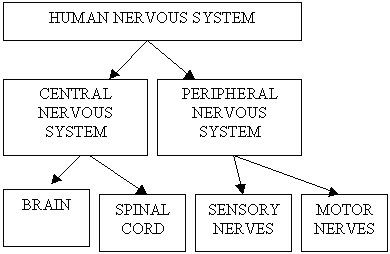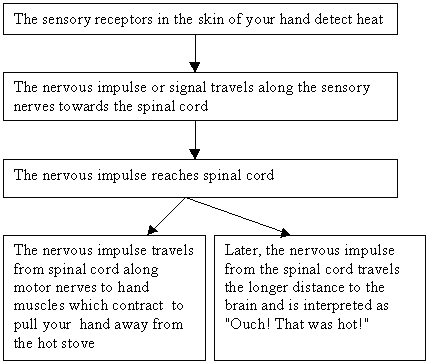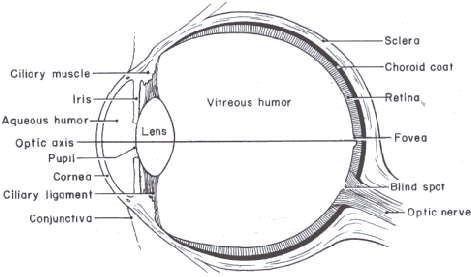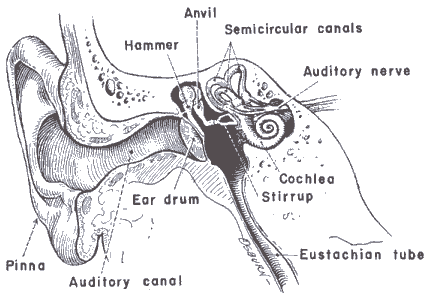

3 MAIN PARTS OF THE NERVOUS SYSTEM
- Brain
- Spinal Cord
- Nerves - Sensory and Motor Nerves
THE NEURONE
- Nerve cells are called neurones.
- A neurone consists of a cell body (with a nucleus and cytoplasm), dendrites which carry electrical impulses to the cell, and a long axon which carries the impulses away from the cell.
- The axon of one neurone and the dendrites of the next neurone do not actually touch. The gap between neurones is called the synapse.
THE CENTRAL NERVOUS SYSTEM
- The Central Nervous System comprises the Brain and the Spinal Cord - the parts enclosed and protected by bone.
- 3 Parts of The Brain
- Cerebrum (Forebrain) - the largest section of the brain, which lets us think, interpret sensory messages, carry out voluntary muscle movements, remember and have consciousness
- Cerebellum (Midbrain) - helps us to keep our balance, and have repetitive muscle control
- Medulla Oblongata (Hindbrain) - control the vital functions of heartbeat, breathing and blood pressure
THE PERIPHERAL NERVOUS SYSTEM
- This is the part of the nervous system that does not include the brain and the spinal cord.
- There are 2 types of nerves - sensory and motor nerves.
- Sensory Nerves carry information about the surroundings from the sense receptors in the skin, eyes, ears, nose and tongue, along the spinal cord to the brain to be interpreted.
- Motor Nerves carry messages from the brain through the spinal cord to the muscles and other organs to produce an action.
- Some of the nerves of the peripheral nervous system are under voluntary control (e.g. controlling motor nerves and muscles when writing). Other nerves are involuntary or uncontrolled (e.g. regulating heartbeat).
A REFLEX ARC
- A reflex arc involves transmission of a nervous impulse or message from sensory receptors to the spinal cord and back to muscles. Later, the message also reaches the brain for interpretation.
- Example: touching your hand on a hot stove

SENSES
- 5 main senses are:
- Touch
- Smell
- Taste
- Sight
- Hearing
- The sense of touch includes touch, pressure, heat, cold and pain.
- A stimulus is a factor in the surroundings that causes the sense receptors to function.
SENSE |
SENSE ORGANS |
STIMULUS |
| Touch, pressure, heat, cold, pain | Skin, joints, internal organs | Internal or external force or temperature |
| Smell | Nose | Airborne chemicals |
| Taste | Taste buds on tongue | Ingested chemicals |
| Sight | Eyes | Light |
| Hearing | Ears | Sound |
THE EYE
The Path of Light through the Eye
Cornea
![]()
Aqueous Humour
![]()
Pupil
![]()
Lens
![]()
Vitreous Humour
![]()
Retina
Functions of the Parts of the Eye

- Cornea - thin transparent layer at the front of the eye
- Aqueous Humour - watery substance that fills the cavity between cornea and lens
- Pupil - a hole to allow to pass to the lens
- Iris - a coloured circular muscle that contracts or relaxes to dilate or constrict the pupil
- Lens - a transparent elastic ball that focuses light rays onto the retina
- Ciliary Ligament - attached to lens, and contracts or relaxes to adjust the lens
- Ciliary Body - attaches the ciliary ligament to the eyeball, and produces both aqueous and vitreous humours
- Vitreous Humour - a more viscous fluid that fills the cavity behind the lens
- Retina - a hemispherical layer of light-sensitive cells (rods and cones) at the back of the eye
- Fovea - a small area of the retina which is directly in line with the centre of the cornea and the lens, and is concentrated with the colour-sensitive cones
- Optic Nerve - the nerve which connects the retina with the vision area of the brain
- 'Blind Spot' - the place on the retina where the optic nerve attaches; has no light-sensitive cones and rods
- Choroid Coat - sheet of cells next to the retina with a black pigment to absorb extra light, and blood vessels to nourish the retina
- Sclera - tough outer coat of the eyeball
Light-Sensitive Sense Receptors - Rods and Cones
- Rods are the more numerous cells that detect shades of black, grey and white light. They are more prevalent in the periphery of the eye.
- Cones are cells that detect coloured light. They are more prevalent in the centre of the retina, particularly the fovea.
- There are no rods nor cones in the 'Blind Spot' where the optic nerve meets the retina.
Vision
- Focus of the Lens - When looking at distant objects, the lens is long and thin in shape. When looking at close objects, the lens is short and wide.
- Binocular Vision - Two eyes are important in judging distance and depth.
- Pupil Size - In bright light, the iris muscle relaxes and the pupil decreases in size so that less light enters the eye. In dim light, the iris muscle contracts and the pupil increase in size to allow more light to enter.
- Short-sightedness (Myopia) - This is a condition where the person can see close objects well, but not distant objects. Light focuses in front of the retina. It is corrected with concave lenses in spectacles.
- Long-sightedness (Hyperopia) - This is a condition where the person can see distant objects well, but not close objects. Light focuses behind the retina. It is corrected with convex lenses in spectacles.
- Astigmatism - This is a condition where the cornea is curved unevenly, so that different light rays focus in different places. It is corrected with spectacles.
THE EAR
Path of Sound through the Ear
OUTER EAR
Pinna
![]()
Auditory Canal
![]()
Eardrum
![]()
MIDDLE EAR
3 Earbones or Ossicles
![]()
Oval Window
![]()
INNER EAR
Cochlea
Functions of the Parts of the Ear

OUTER EAR
- Pinna - funnel-shaped visible flap that directs sound waves into the auditory canal
- Auditory Canal - canal that carries the sound waves to the eardrum
- Eardrum - a thin membrane which is vibrated by sound waves
MIDDLE EAR
- 3 Earbones or Ossicles (Hammer, Anvil and Stirrup) - These are the smallest bones in the body. The eardrum vibrates, and this vibrates the hammer, the anvil and the stirrup one after another. The stirrup then vibrates the Oval Window.
INNER EAR
- Cochlea - This is a spirally coiled tube containing fluid and the actual organ of hearing, the Organ of Corti. Each organ of Corti contains thousands of hairs that are vibrated by the sound waves. The hairs then initiate nervous impulses in the Auditory Nerve which is connected to the auditory areas on the sides of the brain.
Pitch and Amplitude of Sound
- High-pitched sounds causes intese stimulation of the hairs in the cochlea, whereas low-pitched sounds cause less stimulation.
- Loud sounds stimulate a greater number of hairs in the cochlea, than do quiet sounds.
Other Features of the Ear
- Semi-Circular Canals - These are 3 fluid-filled canals that detect the position of the head in 3 dimensions. Impulses are sent through via the auditory nerve to the brain.
- Eustachian Tube - There is a tube that connects each middle ear to the pharynx to equalise air pressure within the middle ear.